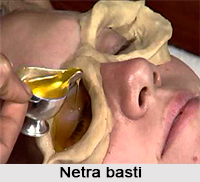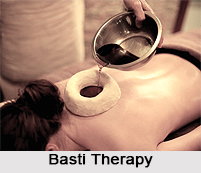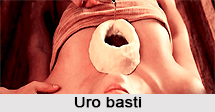 There are several types of basti therapy used in the procedure of Panchakarma. Basti therapy is defined as one of the most effective treatment processes in Ayurveda. Basti fulfils many needs and the type of basti used during the Panchakarma therapy varies as per the intended purpose of the treatment. It is stated in Ayurveda that one type of basti eliminates the aama that has accumulated in the colon from all over the body. The other of basti normalizes functioning of the vata in the body. Once the vata has returned to its normal functioning, the basti therapy is then used for nourishing and revitalizing the dhatus. Basti therapy is defined as the most important procedure in Panchakarma treatment because of its versatile nature. Virechana and vamana accomplish one primary objective that is cleansing the body of toxins.
There are several types of basti therapy used in the procedure of Panchakarma. Basti therapy is defined as one of the most effective treatment processes in Ayurveda. Basti fulfils many needs and the type of basti used during the Panchakarma therapy varies as per the intended purpose of the treatment. It is stated in Ayurveda that one type of basti eliminates the aama that has accumulated in the colon from all over the body. The other of basti normalizes functioning of the vata in the body. Once the vata has returned to its normal functioning, the basti therapy is then used for nourishing and revitalizing the dhatus. Basti therapy is defined as the most important procedure in Panchakarma treatment because of its versatile nature. Virechana and vamana accomplish one primary objective that is cleansing the body of toxins.
Basti therapy also fulfils two additional purposes. Palliative bastis help in balancing the doshas and reduce the signs making the patient more comfortable. The nutritive bastis nurture and rebuild the dhatus and restore their activities by strengthening their immunity. Other than basti therapy no single treatment provides such direct and far reaching benefits. Ayurvedic text defines basti therapy as a major curative treatment. A number of different systems have evolved over time for classifying basti therapy. Types of basti therapy is classified by several means, which are mentioned below -
Classification of Basti Therapy as per site of administration
It is the first major classification scheme of basti therapy. Four types of bastis are classified according to the site of its functioning.
• Netra basti - It is also known as netra tarpana, where medicated ghee to the eyes is applied. The ghee is contained by a dam constructed around the eye sockets that are made of the dough from black gram flour. Netra basti is highly nourishing for the eyes and it helps in removing eye strain and it also improves vision.
• Katti basti - It is retained on the lower back. It uses medicated oils in a container of black gram dough built around the lumbosacral area. This particular form of external basti benefits muscle spasm and rigidity of the lower spine and strengthens the bone tissue in that area.
• Uro basti - It is retained on the chest and heart area. It applies medicated oils in a container that is also constructed of black gram dough around the heart. It helps in reducing pain in the sternum area and strengthening the heart.
•
 Shiro basti - It is administered on the head through the use of a specialized leather container that resembles a hat. It improves the functioning of prana vayu and revitalizes sensory functioning. This type of basti therapy also promotes kaphagenic secretions in the para nasal sinus zone that reduce vascular congestion in the brain. It is extremely helpful in vascular headaches, obsessive compulsive disorders, disorientation, memory loss and sinus headaches.
Shiro basti - It is administered on the head through the use of a specialized leather container that resembles a hat. It improves the functioning of prana vayu and revitalizes sensory functioning. This type of basti therapy also promotes kaphagenic secretions in the para nasal sinus zone that reduce vascular congestion in the brain. It is extremely helpful in vascular headaches, obsessive compulsive disorders, disorientation, memory loss and sinus headaches.
Classification of Basti Therapy as per its Function
Basti therapy as per its functions is divided in several types and these are -
• Shodhana basti - It detoxifies and cleanses the entire system of the body. Shodhana basti is divided into strong treatments that penetrate to the deeper dhatus and milder treatments. It basically works on more superficial level of the dhatus.
• Utkleshana basti - It means promoting secretions in the colon. This type of basti therapy helps in promoting the liquefaction of aama and mala in the colon. It also helps the colon in expelling them.
• Shamana basti - It is basically palliative. It helps in restoring doshic performances and allows the patient to feel better and comfortable by reducing symptoms.
• Lekhana Basti - It means strong and penetrating. It also resembles shodhana basti and is stronger in its effects and generally much larger in volume. It is specifically used for kapha and meda dhatu disorders, where excess fatty substances have accumulated which need to be removed.
• Bruhan basti - Its main purpose is nourishing. In this therapy, highly nutritious substances are used to balance and strengthen the dhatus as well as their metabolism. It increases the body`s resistance to infectious diseases.
• Snehana basti - It is prepared only from oleated substances. It has a greater lubricating effect on both the colon and the body in particular. Moreover, it has a strong pacifying influence on vata and is particularly useful in cracking of joints and also beneficial for those who are emaciated.
• Rasayana basti - It has a rejuvenating power and it can be prepared to rebuild and strengthen either specific dhatus or the entire body. It has a beneficial effect in osteoporosis.
• Vajikarana basti - It treats infertility. It helps in increasing virility and fertility and gives vigour and vitality to the body. It improves the functioning of shukra dhatu.
• Matra basti - It can be given at any time of the day. It is particularly useful to pacify vata aggravation resulting from exercise, travel or stress.
 Classification of Basti Therapy as per its Frequency and Duration
Classification of Basti Therapy as per its Frequency and Duration
There are three additional basti classifications based on particular treatment regimens. These are -
• Karma basti - It usually comprises a month long treatment and is given to people who have vata dominant constitutions and also vata related disorders.
• Kala basti - It basically lasts for fifteen days and is mainly used for patients with pitta dominant constitutions and vata disorders.
• Yoga basti - It is generally given for eight continuous days and it suits kaphic patients with vata diseases.
Hence, Ayurveda shows that all the types of basti therapy are meant to address serious conditions arising from the derangement of the dhatus.




















